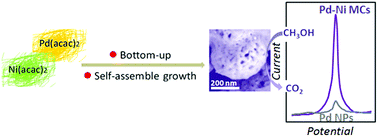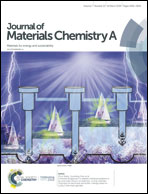Self-assembled growth of Pd–Ni sub-microcages as a highly active and durable electrocatalyst†
Abstract
Metal nanoparticles (NPs) are prone to Ostwald ripening, which usually leads to a quick loss of the catalytic activity. Herein, we report a bottom-up synthesis of Pd35Ni1 sub-microcages (MCs) as a self-supported catalyst for the methanol oxidation reaction (MOR), showing excellent activity and durability. The key is to use a phosphine oxide as a weak capping agent to allow the aggregation of Pd–Ni NPs. The subsequent thermal ripening of the assembled NPs leads to the formation of the Pd–Ni MCs. Due to the high porosity, electrical conductivity, and atomically stepped surfaces, these MCs afford a current density of 3.2 mA cmPd−2 in the MOR in an alkaline medium, which is superior to those of Pd–Ni NPs and Pd NPs. Thanks to the well-defined bicontinuous self-supported structure, more than 91.4% of the current remained after 2000 cyclic voltammetry cycles. The excellent catalytic durability makes the MCs superior to the carbon-supported NP catalysts. This work provides a facile and environmentally benign approach to fabricate porous precious metallic nanomaterials as a highly active and durable electrocatalyst with enhanced utilization of the precious metals.



 Please wait while we load your content...
Please wait while we load your content...